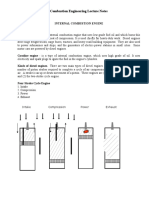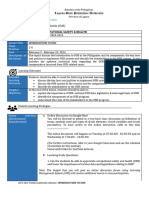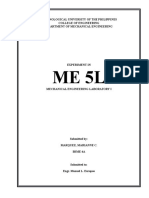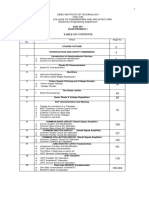Brayton Cycle
Brayton Cycle
Uploaded by
Danang Wahdiat Aulia IshaqCopyright:
Available Formats
Brayton Cycle
Brayton Cycle
Uploaded by
Danang Wahdiat Aulia IshaqCopyright
Available Formats
Share this document
Did you find this document useful?
Is this content inappropriate?
Copyright:
Available Formats
Brayton Cycle
Brayton Cycle
Uploaded by
Danang Wahdiat Aulia IshaqCopyright:
Available Formats
BRAYTON CYCLE: THE IDEAL CYCLE FOR GAS-TURBINE ENGINES
The Brayton cycle was first proposed by George Brayton for use in the reciprocating oil-burning engine that he developed around 1870. Today, it is used for gas turbines only where both the compression and expansion processes take place in rotating machinery. Gas turbines usually operate on an open cycle, as shown in Fig. 1. Fresh air at ambient conditions is drawn into the compressor, where its temperature and pressure are raised. The highpressure air proceeds into the combustion chamber, where the fuel is burned at constant pressure. The resulting high-temperature gases then enter the turbine, where they expand to the atmospheric pressure while producing power. The exhaust gases leaving the turbine are thrown out (not recirculated), causing the cycle to be classified as an open cycle. The open gas-turbine cycle described above can be modeled as a closed cycle, as shown in Fig. 2, by utilizing the air-standard assumptions. Here the compression and expansion processes remain the same, but the combustion process is replaced by a constant-pressure heat-addition process from an external source, and the exhaust process is replaced by a constant pressure heat-rejection process to the ambient air. The ideal cycle that the working fluid undergoes in this closed loop is the Brayton cycle, which is made up of four internally reversible processes: 1-2 Isentropic compression (in a compressor) 2-3 Constant-pressure heat addition 3-4 Isentropic expansion (in a turbine) 4-1 Constant-pressure heat rejection
FIGURE 1 An open-cycle gas-turbine engine
FIGURE 2 A closed-cycle gas-turbine engine.
The T-s and P-v diagrams of an ideal Brayton cycle are shown in Fig. 931. Notice that all four processes of the Brayton cycle are executed in steady flow devices; thus, they should be analyzed as steady-flow processes. When the changes in kinetic and potential energies are neglected, the energy balance for a steady-flow process can be expressed, on a unitmass basis, as (qin qout ) + (win wout ) = (hexit hinlet) (1) Therefore, heat transfers to and from the working fluid are qin = (h3 h2) = cp (T3 T2 ) (2a) and qout = (h4 h1 ) = cp (T4 T1 ) (2b)
FIGURE 3. T-s and P-v diagrams for the ideal Brayton cycle.
Then the thermal efficiency of the ideal Brayton cycle under the cold-air standard as sumptions becomes
Processes 1-2 and 3-4 are isentropic, and P2 _ P3 and P4 _ P1. Thus,
Substituting these equations into the thermal efficiency relation and simplifying give
(3) Where
Development of Gas Turbines
The gas turbine has experienced phenomenal progress and growth since its first successful development in the 1930s. The early gas turbines built in the 1940s and even 1950s had simple-cycle efficiencies of about 17 percent because of the low compressor and turbine efficiencies and low turbine inlet temperatures due to metallurgical limitations of those times. Therefore, gas turbines found only limited use despite their versatility and their ability to burn a variety of fuels. The efforts to improve the cycle efficiency concentrated in three areas: 1. Increasing the turbine inlet (or firing) temperatures This has been the primary approach taken to improve gas-turbine efficiency. The turbine inlet temperatures have increased steadily from about 540C (1000F) in the 1940s to 1425C (2600F) and even higher today. These increases were made possible by the development of new materials and the innovative cooling techniques for the critical components such as coating the turbine blades with ceramic layers and cooling the blades with the discharge air from the compressor 2. Increasing the efficiencies of turbomachinery components The performance of early turbines suffered greatly from the inefficiencies of turbines and compressors. However, the advent of computers and advanced techniques for computer-aided design made it possible to design these components aerodynamically with minimal losses. The increased efficiencies of the turbines and compressors resulted in a significant increase in the cycle efficiency. 3. Adding modifications to the basic cycle The simple-cycle efficiencies of early gas turbines were practically doubled by incorporating intercooling, regeneration (or recuperation), and reheating, discussed in the next two sections. These improvements, of course, come at the expense of increased initial and operation
costs, and they cannot be justified unless the decrease in fuel costs offsets the increase in other costs. The relatively low fuel prices, the general desire in the industry to minimize installation costs, and the tremendous increase in the simple-cycle efficiency to about 40 percent left little desire for opting for these modifications.
FIGURE 4 The ideal gas-turbine cycle utilizing intercooling, reheat, and a regenerator.
EXAMPLE 98 A Gas Turbine with Reheating and Intercooling
An ideal gas-turbine cycle with two stages of compression and two stages of expansion has an overall pressure ratio of 8. Air enters each stage of the compressor at 300 K and each stage of the turbine at 1300 K. Determine the back work ratio and the thermal efficiency of this gas-turbine cycle, assuming (a) no regenerators and (b) an ideal regenerator with 100 percent effectiveness.
Solution An ideal gas-turbine cycle with two stages of compression and two
stages of expansion is considered. The back work ratio and the thermal efficiency of the cycle are to be determined for the cases of no regeneration and maximum regeneration. Assumptions 1 Steady operating conditions exist. 2 The air-standard assumptions are applicable. 3 Kinetic and potential energy changes are negligible. Analysis The T-s diagram of the ideal gas-turbine cycle described is shown in Fig. 946. We note that the cycle involves two stages of expansion, two stages of compression, and regeneration. For two-stage compression and expansion, the work input is minimized and the work output is maximized when both stages of the compressor and the turbine have the same pressure ratio. Thus,
Air enters each stage of the compressor at the same temperature, and each stage has the same isentropic efficiency (100 percent in this case). Therefore, the temperature (and enthalpy) of the air at the exit of each compression stage will be the same. A similar argument can be given for the turbine. Thus,
At inlets: T1 = T3, h1 = h3 At exits: T2 = T4, h2 = h4
and and
T6 = T8, h6 = h8 T7 = T9, h7 = h9
Under these conditions, the work input to each stage of the compressor will be the same, and so will the work output from each stage of the turbine. (a) In the absence of any regeneration, the back work ratio and the thermal efficiency are determined by using data from Table A17 as follows:
A comparison of these results with those obtained in Example 9 5 (single stage compression and expansion) reveals that multistage compression with intercooling and multistage expansion with reheating improve the back work ratio (it drops from 40.3 to 30.4 percent) but hurt the thermal efficiency (it drops from 42.6 to 35.8 percent). Therefore, intercooling and reheating are not recommended in gas-turbine power plants unless they are accompanied by regeneration. (b) The addition of an ideal regenerator (no pressure drops, 100 percent effectiveness) does not affect the compressor work and the turbine work. Therefore, the net work output and the back work ratio of an ideal gas-turbine cycle are identical whether there is a regenerator or not. A regenerator, however, reduces the heat input requirements by preheating the air leaving the compressor, using the hot exhaust gases. In an ideal regenerator, the compressed air is heated to the turbine exit temperature T9 before it enters the combustion chamber. Thus, under the air-standard assumptions, h5 = h7 = h9.
The heat input and the thermal efficiency in this case are
and
You might also like
- Diesel AssignmentDocument12 pagesDiesel AssignmentRichard ValienteNo ratings yet
- Me 313b Fluid Machineries Module Week 10 13 PDF FreeDocument60 pagesMe 313b Fluid Machineries Module Week 10 13 PDF FreeChris TopherNo ratings yet
- Heat Transfer: Precious Arlene Villaroza-MelendrezDocument46 pagesHeat Transfer: Precious Arlene Villaroza-MelendrezMark Jake Rodriguez0% (1)
- Fans and BlowersDocument11 pagesFans and BlowerskennnNo ratings yet
- Fluid Machinery Turbine Lecture 1Document22 pagesFluid Machinery Turbine Lecture 1Jarred TañedoNo ratings yet
- Gas Turbine PowerplantDocument1 pageGas Turbine PowerplantVon A. DamirezNo ratings yet
- MAGATDocument1 pageMAGATReden LopezNo ratings yet
- Fdocuments - in Otto Cycle PresentationDocument97 pagesFdocuments - in Otto Cycle PresentationUTSAV KUMARNo ratings yet
- 1.MEET 315LA MatScie Engineering ME Lab Module 1Document59 pages1.MEET 315LA MatScie Engineering ME Lab Module 1Cj TilamNo ratings yet
- Plate No RaDocument5 pagesPlate No RaEdelleNo ratings yet
- Chapter II Fluid MachineryDocument90 pagesChapter II Fluid MachineryFad TajudinNo ratings yet
- Front Page and Expirement Number 1Document3 pagesFront Page and Expirement Number 1Ron Kristian OpolintoNo ratings yet
- Sample Fans and Blowers Problems #1Document8 pagesSample Fans and Blowers Problems #1DEKUU MidoriyaNo ratings yet
- A. Flat Belt & Pulleys: Unit I Design of Transmission Systems For Flexible ElementsDocument3 pagesA. Flat Belt & Pulleys: Unit I Design of Transmission Systems For Flexible ElementsVijaya Prabhu KumarasamyNo ratings yet
- Assignment 2Document5 pagesAssignment 2Noraishah Syahirah Azhar100% (1)
- Combustion Engineering Lecture Notes: Intake Compression Power ExhaustDocument13 pagesCombustion Engineering Lecture Notes: Intake Compression Power ExhaustFake AccountNo ratings yet
- Me Lab 3Document27 pagesMe Lab 3Jerome Vega AndesNo ratings yet
- Gucor, Rubie-PME 424 Lab. Report 1Document19 pagesGucor, Rubie-PME 424 Lab. Report 1rubie.gucorNo ratings yet
- Engineering Bosh SLM1Document26 pagesEngineering Bosh SLM1Blue PandaNo ratings yet
- Lab 2 ThermalDocument18 pagesLab 2 ThermalMuhamad Arif100% (1)
- Design Procedure For Flat BeltDocument2 pagesDesign Procedure For Flat BeltKutty AravindNo ratings yet
- Anemometer and Air Velocity MeasurementDocument2 pagesAnemometer and Air Velocity MeasurementSHERWIN MOSOMOSNo ratings yet
- Module 3 - Pump Configuration Specific Speed and Affinity Laws - No AnsDocument17 pagesModule 3 - Pump Configuration Specific Speed and Affinity Laws - No AnsRoi Vincent AnitNo ratings yet
- Chapter 9Document4 pagesChapter 9Marco LuigiNo ratings yet
- Bufe Aaron A. 1st Checking LectureDocument18 pagesBufe Aaron A. 1st Checking LectureArabia, Elmo C.No ratings yet
- SET B With Answer Key Quiz 2 Fluid Machineries (Prof. Enh. 2)Document4 pagesSET B With Answer Key Quiz 2 Fluid Machineries (Prof. Enh. 2)Famela GadNo ratings yet
- Activity 3 TANGONAN - PlanimeterDocument9 pagesActivity 3 TANGONAN - PlanimeterBryan TangonanNo ratings yet
- Emittance R Emittance R Config. Factor RDocument6 pagesEmittance R Emittance R Config. Factor RAJNo ratings yet
- Vibration Engineering Problem Set 1Document5 pagesVibration Engineering Problem Set 1John Gilbert Borres100% (1)
- MODULE 2 Lesson 1Document12 pagesMODULE 2 Lesson 1zyx xyzNo ratings yet
- Problems On Screws PDFDocument6 pagesProblems On Screws PDFJerome BalatbatNo ratings yet
- Experiment 2Document9 pagesExperiment 2Narry StrummerNo ratings yet
- (x3) Problem 1 - 4 Industrial CompressorDocument13 pages(x3) Problem 1 - 4 Industrial CompressorLester Alfred M. OlasimanNo ratings yet
- Elements of Mathematics, Engineering Economics and Basic Engineering SciencesDocument15 pagesElements of Mathematics, Engineering Economics and Basic Engineering SciencesJaypee BucatcatNo ratings yet
- Anto ME463 Plate No. 3Document18 pagesAnto ME463 Plate No. 3Eman Lampago AntoNo ratings yet
- Vibration Engineering: Lesson 1 - Introduction To Vibration ControlDocument8 pagesVibration Engineering: Lesson 1 - Introduction To Vibration ControlAce Heart Rosendo AmanteNo ratings yet
- Dimensionless Numbers & Problem 4.5 - 1Document56 pagesDimensionless Numbers & Problem 4.5 - 1Zhu Chen ChuanNo ratings yet
- Sheldon - S File 3Document7 pagesSheldon - S File 3Prince Leonard R. VergaraNo ratings yet
- Air Compressor ProblemsDocument15 pagesAir Compressor ProblemsViswajith Menon100% (1)
- Handling of Gaseous Fuels: Caroline P. Mirandilla Catherine C. Glorioso Josua Royce S. RuzolDocument16 pagesHandling of Gaseous Fuels: Caroline P. Mirandilla Catherine C. Glorioso Josua Royce S. RuzolRonald Andrei DaguioNo ratings yet
- Ece 301 - Electronics 1 June 2009Document204 pagesEce 301 - Electronics 1 June 2009Jamael AbulaisNo ratings yet
- Chapter 9-Hydroelectric Plant PDFDocument118 pagesChapter 9-Hydroelectric Plant PDFsindyNo ratings yet
- Mech-V-Design of Machine Elements I U6Document27 pagesMech-V-Design of Machine Elements I U6Haniya FathimaNo ratings yet
- Design A Bell Crank'95Document27 pagesDesign A Bell Crank'95Al DrinNo ratings yet
- Cycle EngineDocument2 pagesCycle Enginecobalt boronNo ratings yet
- XI Geothermal Power PlantDocument11 pagesXI Geothermal Power PlantalbertNo ratings yet
- Lecture 3 IC Engine - DIESELDocument20 pagesLecture 3 IC Engine - DIESELMai Maiyaw100% (1)
- Unit 5Document63 pagesUnit 5RajeshKumarNo ratings yet
- Solved Problems of Air Conditioning Systems: Mechanical Power and Energy DeptDocument16 pagesSolved Problems of Air Conditioning Systems: Mechanical Power and Energy DeptSachin MahatoNo ratings yet
- Supplementary Alg2Document4 pagesSupplementary Alg2chxth staroNo ratings yet
- Simple (Ideal) Vapor Compression Refrigeration Cycle ProblemsDocument3 pagesSimple (Ideal) Vapor Compression Refrigeration Cycle Problemssajawal hassanNo ratings yet
- MathDocument1 pageMathmikaNo ratings yet
- Chapter 8B - Gas Power Plant Brayton CycleDocument17 pagesChapter 8B - Gas Power Plant Brayton CycleBF3nobel100% (1)
- Applied Thermodynamics 191 224Document34 pagesApplied Thermodynamics 191 224www.drefferrgamingNo ratings yet
- Unit-6: Gas Turbines and Jet PropulsionDocument9 pagesUnit-6: Gas Turbines and Jet PropulsionSamrudh Manjunath100% (1)
- Unit 3 Gas Turbines AND JET PROPULSIONDocument99 pagesUnit 3 Gas Turbines AND JET PROPULSIONSANTHOSH NAGARAJANo ratings yet
- University of Karbala Department of Mechanical Lecture Notes - Power Plants by Fadhel Al-MousawiDocument27 pagesUniversity of Karbala Department of Mechanical Lecture Notes - Power Plants by Fadhel Al-Mousawiحامد عبد الشهيد حميد مجيد100% (2)
- Chapter5 2Document55 pagesChapter5 2Digonto ChowdhuryNo ratings yet
- Pplied: ThermodynamicsDocument86 pagesPplied: ThermodynamicsAlaa Shammaa100% (1)



























































